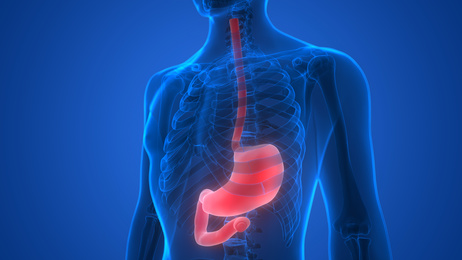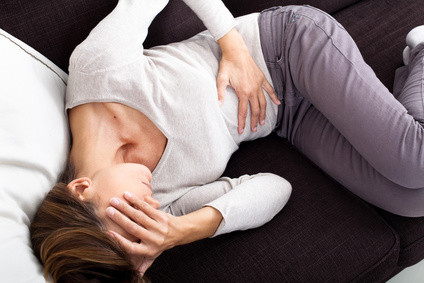Squeezing Stomach Pain (Abdomen) Causes
There are many different sensations that may be experienced which is not always described according to strict medical definitions. However, even these crude descriptions can at times be helpful in identifying the underlying cause before diagnostic investigations can be conducted. Abdominal pain is common problem and can be described in various different ways. A squeezing pain is one such type of description.
Squeezing Sensation in the Stomach
A squeezing sensation is seen with certain conditions. Stomach pain usually infers that the problem is in the stomach itself but many people refer to the abdomen as the stomach although this is incorrect. Normally the stomach is located in the right upper quadrant of the abdomen. However, there are many other organs in this quadrant and pain here does not necessarily mean that it is from the stomach. Kidney and spleen pain may be felt here as well.
It is important to note that stomach pain may sometimes not be due to the stomach or any other organ in the abdominal cavity. Instead it may be pain from the chest cavity. Certain heart conditions can present with squeezing pain which may be felt in the upper abdomen. Angina pectoris and a heart attack can present in this way. Therefore it important to watch out for warning signs like difficulty breathing, excessive sweating and dizziness.

Causes of Squeezing Stomach Pain
Some of the more common digestive causes of a squeezing pain in the abdomen has been discussed below. However, it is important to note that there may be many other causes. Women for example should consider gynecological conditions especially when the squeezing pain is felt in the lower parts of the abdomen and pelvis. Sometimes it is difficult to identify the exact cause of a squeezing stomach pain without conducting further diagnostic investigations.
Hiatal Hernia
A hiatal hernia is a structural problem where a portion of the stomach slips into the chest cavity. Normally the esophagus passes down through a hole in the diaphragm. This hole is known as the esophageal hiatus. It is large enough for the esophagus to pass through but small enough to prevent the stomach from entering. When the hole widens then a portion of the stomach may then slide into the chest cavity at certain times.
Hiatal hernia symptoms include:
- Excessive belching
- Chest pain and heartburn
- Upper abdominal pain
- Swallowing problems
- Bloated sensation
Gallstones
Gallstones is a common problem whereby hard masses form from the bile in the gallbladder. Small stones are often passed out without causing any symptoms or problems. However, larger stones can block the gallbladder duct and or bile ducts resulting in various symptoms as the outflow of bile is affected. The problem tends to recur therefore the treatment of choice for gallstones is to remove the gallbladder.
Gallstone symptoms include:
- Upper middle to upper right abdominal pain
- Back pain between the shoulder blades
- Right shoulder pain
- Jaundice
- Fever and chills
The episodes of pain are usually sudden and intense, lasting for about 30 minutes to 2 hours and then subsiding.
Irritable Bowel Syndrome
Irritable bowel syndrome (IBS) is a functional bowel disorder where there is abnormality in movement within the intestines (bowel motility). It is marked by abdominal pain and alterations in bowel habit, such as diarrhea or constipation. The exact cause of IBS is unknown and there is no cure. IBS is usually diagnosed when all other known pathologies that account for the same symptoms has been excluded as a possible cause.

The symptoms of IBS includes:
- Abdominal cramps
- Diarrhea, constipation or both.
- Excessive gas.
- Abdominal distension.
These symptoms usually arise as episodes that arise with certain triggers and resolve on their own.
Food Intolerance
A food intolerance is a condition where the body cannot digest certain nutrients. These residual nutrients in the gut then give rise to a host of symptoms. One of the more common types is lactose intolerance where a deficiency of the enzyme, lactase, impedes the digestion of the milk sugar lactose. However, the term food intolerance is also loosely used to refer to other conditions like food sensitivities, allergies and malabsorption syndromes.
The symptoms of food intolerance includes:
- Nausea and sometimes vomiting.
- Diarrhea.
- Excessive gas.
- Bloating.
- Indigestion.
- Abdominal distension.
These symptoms arise after eating the problem food.
Constipation
Any change in bowel habit, both diarrhea and constipation, can cause abdominal pain. Constipation is not a disease but a symptom of some underlying disease. There are many different causes of constipation. Some are diet and lifestyle related like inadequate water intake, low fiber diet and not being physically active. Other times constipation may be a symptom of conditions like IBS, bowel obstruction, nerve problems, hypothyroidism, diabetes, pregnancy and even depression.
The symptoms of constipation includes:
- Hard stool
- Straining to pass stool
- Infrequent bowel movements (less than 3 times per week)
- Abdominal cramps
- Sensation of fullness in the rectum
There may be other symptoms like rectal bleeding and itchy anus which are a due to complications of constipation like hemorrhoids.
Trapped Gas
Gas is constantly produced in the bowels by the chemical reactions of digestion as well as the activity of bacteria. A significant amount of gas also reaches the bowels when it is swallowed. Collectively this gas is passed out of the bowels through the anus and is referred to as flatus. However, when the gas is trapped and accumulates it can stretch the bowel walls and this can cause reflex spasms. Fecal impaction and other causes of intestinal blockage can also be a contributing factor.
Symptoms include:
- Absence of flatus
- Pain relieved by passing gas and with defecation
- Palpable lump or ball on bowel wall (sometimes)
- Loud bowel noises
Abdominal Wall
The abdominal wall is often a source of abdominal pain but is ignored for problems within the abdominal cavity. The large flat sheet muscles of the abdominal wall may at times go into spasm with overactivity, injury and for other reasons and this gives rise to a cramping pain. There may also be soft tissue injury with can include the skin, fat, fascia or muscles that make up the abdominal wall. Read more on abdominal muscle pain.
References
- Acute abdominal pain in adults. American Academy of Family Physicians
Last updated on September 5, 2018.





